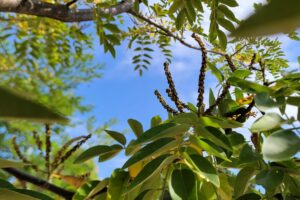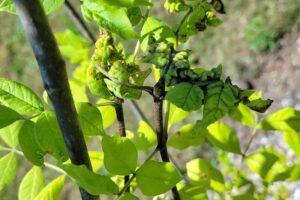Tag: summer
Leaflet: Aphids
Aphids are everywhere, but don’t worry!
We’ve been getting a few inquiries about aphids this summer. And with the arrival of the emerald ash borer (a devastating issue we’ll keep you posted on), we have plenty of reasons to keep an eye out for pests. In the case of aphids, however, we don’t need to fret about them on our trees like we do in our veggie gardens.
In almost all instances, you don’t need to take any action—the tree can take care of itself. Aphids will only make a noticeable impact if the tree is still working to establish itself, or is somehow otherwise weakened. We often see them on Oregon ash, like the one pictured. If some wilting or crinkled leaves have you worried, here are some action steps you can take. Some folks might want to go straight to spraying, but pesticides really aren’t necessary to deal with aphids.
If you have more than just a few aphids on your leaves, the first thing to try is to just rinse them off with water. A good hose down will take care of a minor infestation. If that doesn’t quite do the trick, you can spray with soapy water. A treatment like this just once or twice a year will be enough.
If you see any ladybugs alongside the aphids, that’s great! Ladybugs will eat the aphids, and their larvae will really go to town feasting on them.
Aphids are everywhere—there are even tiny ones floating in the air we breathe. Some trees, like littleleaf linden, will have so many aphids that you may feel a mist of aphid “honeydew” when you walk underneath. You guessed it, that’s aphid poop. Just think of it as a nice reminder that trees are part of a larger ecosystem of living things.
Leaflet: Summer Glory

Shop now, plant later
Now is when trees are in their full glory. You can see it, smell it, and feel it whenever you walk around the neighborhood. It’s not a good time to plant trees—we’ll wait until our planting season, October-April—but now is the time to be thinking about what tree you might want to plant. Look for the species on a Friends of Trees tag. Consider how big a tree gets when it’s mature.
“When we call you later this year to see what tree you want, you won’t be able to look around and see what a tree looks like in the middle of summer,” says Neighborhood Trees Senior Specialist Andrew Land. “Summer is an outstanding time to look around.”
Beyond finding a tree whose glory really speaks to you, now is also a great time to think critically about the conditions where a particular tree can succeed. A core aspect of the Friends of Trees ethos is right tree, right place. We want every tree to survive and thrive.
If you see a tree you really like and think, maybe I want one of those, observe the place that it’s in. Consider the conditions: sunlight, moisture, competition, space. Compare those to the conditions in your own yard where you might want a tree.
When we talk about a tree getting full sun, we’re really only talking about the growing season from mid-April through September. The sun exposure in your yard changes considerably from season to season. Now is the time to study how much sun your new tree would get next summer.
“Thinking ahead is how we set up a tree and its steward—you—for success,” Andrew says.
We always invite you to connect with staff about tree selection. And we encourage you to keep an open mind to something new and different. Don’t be afraid of big trees. Consider trees that will be more resilient to climate change. Glory is subjective, and there are so many factors beyond appearance.
“Take the Hardy Rubber Tree, for example,” Andrew says. “It’s nondescript. You wouldn’t necessarily call it pretty. But it’s the best air filter of all the trees.”
Or take the Amur Maackia. It’s not known for its spring flower or its fall color, but it casts a beautiful dappled shade and does really well in the urban environment. When it comes down to it, survivability is the biggest priority.
“Think of all the benefits that a tree provides to people and community,” Andrew says. “Those benefits expand exponentially every year that a tree survives, which is why we want every tree to last as long as possible.”
Everything you could want to know about the ooze tube
By Kate Farrington

So, what is an ooze tube? It is a nifty little drip irrigation bag you can purchase for $20 from Friends of Trees to help water your trees in the summer months! If you have trouble remembering to water your tree, or you are a landlord and don’t get to visit your tree very often, the ooze tube allows you to only water every two to three weeks, instead of once a week.
And ooze tubes are super easy to install! Check out our video, which walks you through how to install your very own ooze tube.
Have an ooze tube but are concerned about that cut in the top of the bag? You are not alone. But there’s actually nothing to worry about! This cut is the opening that allows you to fill the bag with a hose. Above is a picture of what it should look like. If your bag is actually damaged, please let us know and we’d be happy to replace it.
If you would like to purchase an ooze tube, just drop by the Friends of Trees office at 3117 NE Martin Luther King Jr Blvd, Portland, between 9:00 am and 5:00 pm. Someone in the Neighborhood Trees program will be happy to help you purchase your ooze tubes.
–Farrington is a Neighborhood Trees Specialist with Friends of Trees.

